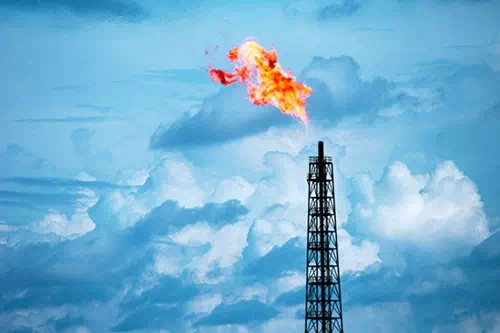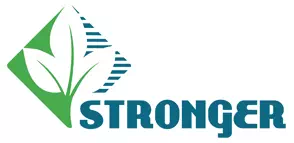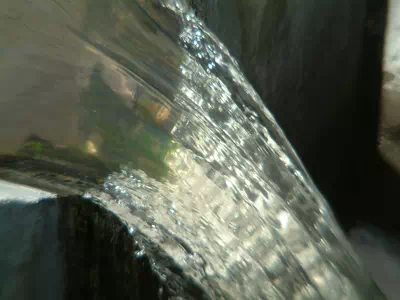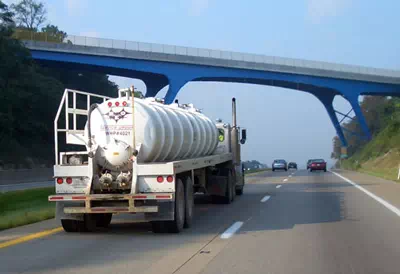

|
Produced Water Discharges
This section provides the following information:
Water is an integral component of the oil and natural gas extraction process in many geologic basins. With the recent increase in the number of shale oil and gas wells, there has been an increase in the volume of oil and natural gas extraction wastewater (including flowback and produced water) that requires disposal. Although other options are being pursued to reduce the amount of water used (e.g., fracturing with nitrogen, re-using wastewater to replace/supplement fresh water in formulating future fracturing fluid), wastewater disposal remains a management concern. The basic options for disposal of oil and natural gas extraction wastewater operations include:
Oil and natural gas exploration, extraction and production can result in the generation of wastewater, other than stormwater. Two types of wastewater common to these operations include:
When hydraulic fracturing is employed during well production, the wastewater that is recovered from an oil or natural gas well makes a transition from flowback water to produced water. The transition point, which can be somewhat arbitrary, is usually identified according to the rate of return, measured in barrels per day (bpd):
The chemical composition of flowback and produced water vary in terms of constituents and concentration, therefore a chemical analysis of the wastewater can also be used to distinguish between flowback and produced water. Other wastes that may be associated with land-based oil and natural gas extraction and production include drilling muds and cuttings that may be produced during the drilling phase and, waste acids and other toxic substances that may be produced during well workover. The CWA regulates both direct and indirect discharges. Direct discharges come from "point sources" which are defined as any discernible, confined, and discreet conveyance, including but not limited to any pipe, ditch, channel, tunnel, conduit, well, discrete fixture, container, rolling stock, vessel, or floating craft from which pollutants are or maybe discharged. The National Pollutant Discharge Elimination System (NPDES) program (CWA section 402) controls direct discharges into navigable waters. Indirect discharge refers to the introduction of pollutants from a non-domestic source into a publicly owned waste-treatment system. Indirect dischargers are typically commercial or industrial facilities whose wastes enter local sewers.
The discharge of produced water to surface waters of the U.S. is subject to requirements under the Clean Water Act (CWA) (note that underground injection of produced water is regulated under the Safe Water Drinking Act). The overriding CWA regulation affecting onshore oil and natural gas extraction direct wastewater discharges is the Oil and Gas Onshore Extraction Point Source Category rule (40 CFR Part 435, Subpart C). In essence, this regulation prohibits point source discharge of wastewater pollutants into navigable waters from any source associated with production, field exploration, drilling, well completion, or well treatment (i.e., produced water, flowback, drilling muds, drill cuttings, and produced sand). For the most part, operators use different technologies to comply with this no-discharge regulation, including underground injection and use of pits or ponds for evaporation. However, where direct discharge of wastewater is an option for disposal of wastewater, the owner/operator must obtain a National Pollutant Discharge Elimination System (NPDES) permit, pursuant to Section 402 of the CWA. NPDES permits are issued by EPA or authorized states/tribes. When 40 CFR Part 435, Subpart C applies:
There is an exception to the no-discharge requirements for onshore facilities located in the continental U.S. and west of the 98th meridian. This regulation, found at 40 CFR Part 435, Subpart E allows discharges of produced waters if it is of sufficient quality to be used in agriculture or wildlife propagation. For facilities in this subcategory, produced water may be discharged into navigable waters so long as it does not exceed limitations for oil and grease, and is put to use for agricultural purposes. In addition, water quality-based effluent limitations developed by the permitting authority apply to these discharges. Discharge of waste pollutants other than produced water is prohibited (40 CFR Part 435.50). 40 CFR Part 435 also contains requirements that apply to the "indirect discharge" of wastewater (e.g., discharge to a publicly owned treatment works) from unconventional formations. 40 CFR Part 437 contains provisions for discharge via off-site centralized waste treatment facilities. These options are discussed below. Indirect Discharge to Publicly Owned Treatment Works
Publicly owned treatment works (POTWs) are primarily designed as biological wastewater treatment systems and their main function is to treat household wastewater. In order to control some pollutants that are not compatible with these biological treatment systems, EPA established a "Pretreatment Program" that sets national and local pretreatment standards necessary to protect the local POTW. General Pretreatment Regulations establish responsibilities of Federal, State, and local government, industry and the public to implement Pretreatment Standards to control pollutants from the industrial users. EPA has developed general pretreatment standards and technology-based standards for industrial users of POTWs in many industrial categories. Different standards may apply to existing and new sources within each category. "Categorical" pretreatment standards applicable to an industry on a nationwide basis are developed by EPA. In addition, another kind of pretreatment standard, "local limits," are developed by the POTW to help the POTW achieve the effluent limitations in its NPDES permit. There are currently categorical pretreatment standard that apply to wastewater from unconventional oil and natural gas extraction activities which can be found at 40 CFR 435.33. Like the provisions that apply to direct discharges under 40 CFR Subpart C, the pretreatment standards for unconventional oil and natural gas extraction activities are a zero discharge of pollutants standard. In addition, the general pretreatment regulations apply to all industrial users. In addition, 40 CFR 435 Subpart D includes a no discharge requirement for discharges into a POTW for both new and existing sources. The applicable regulations covering indirect discharge, are found at 40 CFR 403.5. The general pretreatment regulations prohibit the introduction of wastewater into a POTW in certain defined circumstances, including the introduction of any pollutants which "pass through" or cause "interference" with POTW operations. 40 CFR Part 403.3(k)(1) defines interference as inhibiting or disrupting the POTW, its treatment processes or operations, or its sludge processes, use or disposal. Therefore, in addition to prohibiting the introduction of pollutants into the POTW that would disrupt the treatment process, the general regulations also prohibit the introduction of pollutants in concentrations that contaminate biosolids and make them inconsistent with the POTW's chosen method of use or disposal. Pass through is defined at 40 CFR 403.3(p) to mean "a discharge which exits the POTW into waters of the U.S. in quantities or concentrations which, alone or in conjunction with a discharge or discharges from other sources, is a cause of a violation of any requirement of the POTW's NPDES permit (including an increase in the magnitude of a violation)." All non-domestic discharges must comply with these requirements. See 40 CFR 403.5(a) and (b). Indirect Discharge to Centralized Waste Treatment
One wastewater management option available to drilling operations is to transfer the produced water off-site to a centralized waste treatment (CWT) facility after transporting it by truck or rail. In turn, the CWT treats the wastewater and discharges it directly to waters of the U.S. or indirectly via a publicly owned treatment works (POTW). When produced water is transported to a CWT facility, it is the responsibility of the CWT facility to properly treat and discharge it. The CWT facility is subject to applicable limitations imposed on its discharge through its NPDES permit, or the pretreatment program control mechanism in the case where the CWT facility discharges to a POTW. Discharges from a CWT facility are subject to the effluent limitations guidelines and standards established under 40 CFR Part 437, which cover both direct and indirect discharges. NPDES permit effluent limits are set based on:
To meet these standards, the CWT facility may limit the volume and composition of produced water it accepts from industry. The CWA allows EPA to authorize state and tribal governments to implement the NPDES Permit Program if they meet regulatory requirements. Authorized states and tribes perform many of the permitting, administrative, and enforcement aspects of the NPDES Program. In states that have been authorized to implement CWA programs, EPA still retains oversight responsibilities. Regardless of whether a state/tribe is authorized to implement either the NPDES (direct) or the pretreatment (indirect) program, if it develops its own program, it may enforce requirements more stringent than federal standards. To check on state authorization, visit EPA's state program status webpage. Oil and Gas Extraction Wastewater Management. EPA has completed a stakeholder engagement effort that sought input on how the Agency, states, tribes and stakeholders regulate and manage wastewater from the oil and gas industry. Centralized Waste Treatment Effluent Limitations Guidelines and Pretreatment Standards, 40 CFR 437 (EPA, June 2001). EPA designed this guide to help owners and operators of centralized waste treatment (CWT) facilities that are small entities - whether they are small businesses, small government jurisdictions or small non-profit organizations -- understand and comply with the CWT effluent guidelines limitations and pretreatment standards. Centralized Waste Treatment Final Fact Sheet (EPA). EPA is issued Effluent Limitations Guidelines, Pretreatment Standards, and New Source Performance Standards for the Centralized Waste Treatment Point Source Category. This regulation establishes technology-based effluent limitations guidelines for the discharge of pollutants into waters of the U.S. and into publicly owned treatment works (POTWs) by existing and new facilities that treat or recover hazardous or non-hazardous industrial waste, wastewater, or used material from off-site (also see related documents: Development Document and Economic Analysis). Detailed Study of the Centralized Waste Treatment Category for Facilities Managing Oil and Gas Extraction Wastes (EPA, May 2018). EPA conducted a study of CWT facilities accepting oil and natural gas extraction wastewater from 2014 to 2017. EPA has prepared a compilation of data collected to date, including information on CWT facilities that accept such wastewater, available treatment technologies (and their associated costs), discharge characteristics, financial characteristics of CWT facilities and the environmental impacts of discharges from CWT facilities. Regulating Natural Gas Drilling in the Marcellus Shale under the NPDES Program (EPA, 2011). This memo and associated FAQs clarify discharge options under the NDPES program and treatment and water quality issues associated with disposal of hydraulic fracturing flowback water. Chemistry of Produced Waters in the U.S. (U.S. DOI). Most areas of oil and natural gas production are well represented in this dataset except the Appalachian Basin. EPA Multi-Sector General Permit (EPA). The 2015 MSGP provides coverage for industrial facilities (PDF) located in five states, and in certain Indian Country lands, as well as states where EPA still remains the NPDES permit authority for federal operators. Municipalities and Wastewater Treatment Plants (EPA). This page provides links to the various program area pages. Natural Gas Drilling in the Marcellus Shale NPDES Program Frequently Asked Questions (EPA, March, 2011). This EPA document provides an overview of applicable regulations in a Q&A format. Publicly Owned Treatment Works General Permit (EPA). The POTW general permit authorizes discharges of wastewater from certain POTWs and other treatment works treating domestic sewage (collectively "facilities"). Regulating Natural Gas Drilling in the Marcellus Shale Under the NPDES Program (EPA, March 2011). Memorandum outlining wastewater issues resulting from shale gas extraction.
|
Funded by EPA through a Cooperative Agreement
|
 |
||
About | Technical Topics | Federal Statutes & Regulations - US EPA | Federal Statutes & Regulations - Non-EPA | Emergency Response |
|
EPA Resources | State/Local Resources | Other Resources | Acronyms | Search | Disclaimer | Home






